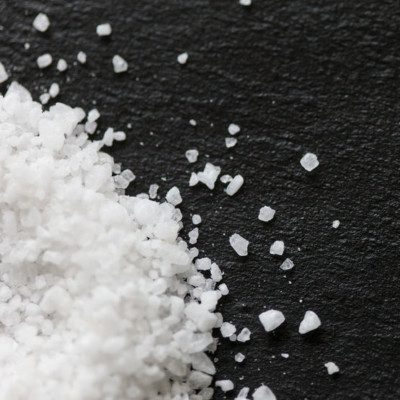Function
Sodium chloride salt is one of the four essential ingredients in bread. Eliminating or drastically reducing the level of sodium chloride in a bread formula can cause dramatic changes in the texture, taste and overall quality of bread.
Although added in relatively small amounts, salt can have a major impact on the dough and final baked product by:
- Increasing shelf life, a result of reducing free water and preventing microbial spoilage
- Stabilizing the yeast fermentation rate by drawing out water from inside the yeast cell. This increases osmotic pressure in its semipermeable membrane and decreases its leavening ability.
- Strengthening gluten structure due to salt shielding effect on the gluten molecules
- Increasing dough mixing time. This is the reason why salt is typically added just before the end of mixing in large commercial bakeries.3
- Improving crumb grain
- Enhancing flavor
Sodium bicarbonate and sodium-based phosphate acids are key ingredients that provide the necessary aeration in chemically-leavened products such as cakes, pancakes and muffins. This aeration is crucial to achieve the right texture and appearance in the final product. Sodium-based phosphate acids are typically the most functional leavening acids, providing a wide range of reaction speeds to match specific products and processes.
Alternatives to sodium
- Potassium chloride: provides similar functionality to table salt but has the disadvantage of generating bitter taste
- Autolyzed yeast extract (AYE): is essentially composed of yeast proteins broken down into simpler compounds and free amino acids that can be used to replace the flavor of salt it can be used in conjunction with potassium chloride
Chemical leavening alternatives
- Potassium bicarbonate: delivers carbon dioxide when heated or reacted with a leavening acid, and is a suitable replacement for sodium bicarbonate. Due to its mildly bitter aftertaste, using the correct amount of leavening acid and a grade of potassium bicarbonate with the right particle size is crucial.
- Calcium-based phosphate acids: provide the necessary acidity to react with a bicarbonate and produce carbon dioxide. However, calcium-based phosphate acids are typically less functional than their sodium-based counterpart, meaning recipe or process changes may be required to maintain product quality.
- Organic acids: are only suitable for home baking due to their fast reaction speed. In an industrial setting, these acids react too quickly, resulting in inconsistency and waste.
- Glucono-delta lactone (GDL): is one of the few organic leavening acids suitable for industrial baking as it must first hydrolyse (react with water) to convert to an acid (gluconic acid). Despite providing a more controlled reaction speed, GDL is typically used in combination with other leavening acids due to its low neutralizing value (NV) and limited functionality.
Application
In baking, salt is a key ingredient in the production of bread and other baked goods. It controls the rate of fermentation and aids in gluten development. For chemically leavened products, up to 50% of the sodium may come from baking powder.
The effect of potassium chloride on bread rheological properties have been found to be comparable to that of sodium chloride.2,4 No negative effect on acceptability for consumers was reported when 30% sodium chloride was replaced with potassium chloride in white bread.5 Similarly, substituting 32% NaCl with a mixture of potassium chloride, magnesium sulfate, and magnesium chloride in a brown bread system did not affect the texture and flavor of the baked product.6
FDA regulation
Salt is considered ‘GRAS’ and its usage is regulated by 21CFR100.155.7
References
- SACN report. Salt and Health. Scientific Advisory Committee on Nutrition. The Stationary Office, Norwich, UK. (2003).
- Doyle, M.,E. FRI BRIEFINGS: Sodium Reduction and its Effects on Food Safety, Food Quality, and Human Health: a Brief Review of Literature (pp. 1–12. Food Research Institute, University of Washington-Madison). (2008).
- Miller, R. A., and Hoseney, R. C. Role of salt in baking. Cereal Foods World, 53(2008): 4-6.
- Chen, G., Hu, R., and Li, Y. Potassium chloride affects gluten microstructures and dough characteristics similarly as sodium chloride. Journal of Cereal Science, (2018) 82: 155-163.
- Braschi, A., Gill, L., and Naismith, D. J. Partial substitution of sodium with potassium in white bread: feasibility and bioavailability. International journal of food sciences and nutrition, (2009) 60 (6): 507-521.
- Charlton, K. E., Macgregor, E., Vorster, N. H., Levitt, N. S., and Steyn, K. Partial replacement of NaCl can be achieved with potassium, magnesium and calcium salts in brown bread. International journal of food sciences and nutrition. (2007) 58(7): 508-521.
- CFR – Code of Federal Regulations Title 21CFR100.155. Accessdata. Fda. gov. April 01. 2019. https://www.accessdata.fda.gov/scripts/cdrh/cfdocs/cfcfr/cfrsearch.cfm?fr=100.155. Last accessed by Jan 21 2020.

